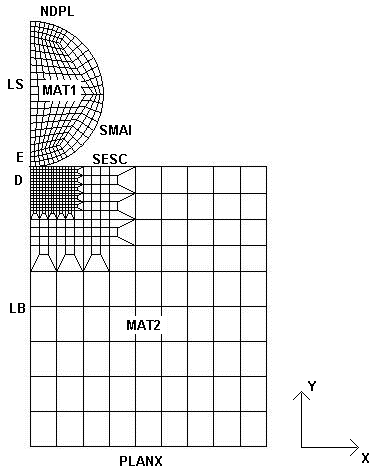7. E modeling#
7.1. Characteristics of modeling#
The symmetry of revolution of the problem allows axisymmetric modeling: The block is represented by the section of its half and the sphere is represented by its surface potentially in contact, they are meshed with axisymmetric 2D elements.
A node-mesh contact is defined between the two structures.
An imposed displacement load is applied to the upper part of the sphere, which is rigidified by a high Young’s modulus.

Boundary condition:
symmetry of revolution: the nodes located on the \(Y\) axis (group of nodes \(«\mathrm{LB}»\) and \(«\mathrm{LS}»\)) are blocked in the direction \(X\) (DX = 0),
embedding the base: the nodes in group \(«\mathrm{PLANX}»\) are blocked in the directions \(X\) and \(Y\) (DX = DY = 0),
rigid body movements are suppressed by imposing a link following \(y\) between node \(E\) belonging to the sphere and node \(D\) belonging to the massif.
Loads:
An imposed displacement is applied to the upper part of the sphere (group of nodes \(«\mathrm{NDPL}»\)) in the direction \(Y\): Loading from 0 to \(–100.\mathrm{mm}\)
7.2. Characteristics of the mesh#
Number of knots: 688
Number of meshes and type: 625 QUAD4 and 241 SEG2.
7.3. Tested values#
Identification |
Movement \((\mathrm{mm})\) |
Reference |
Aster |
% tolerance |
Reaction \((N)\) |
20 |
—2.03804E+06 |
-2.0892265E+06 |
5 |
Reaction \((N)\) |
40 |
—4.07608E+06 |
-4.0928499E+06 |
5 |
Reaction \((N)\) |
60 |
—6.11412E+06 |
-5.8467590E+06 |
5 |
Reaction \((N)\) |
80 |
—8.15217E+06 |
-7.6820567E+06 |
10 |
Reaction \((N)\) |
100 |
—1.01902E+07 |
-9.1299258E+06 |
15 |
7.4. notes#
The results are slightly better than those of modeling A.
We notice a calculation time 5 times greater than the latter, using method CONTRAINTE.